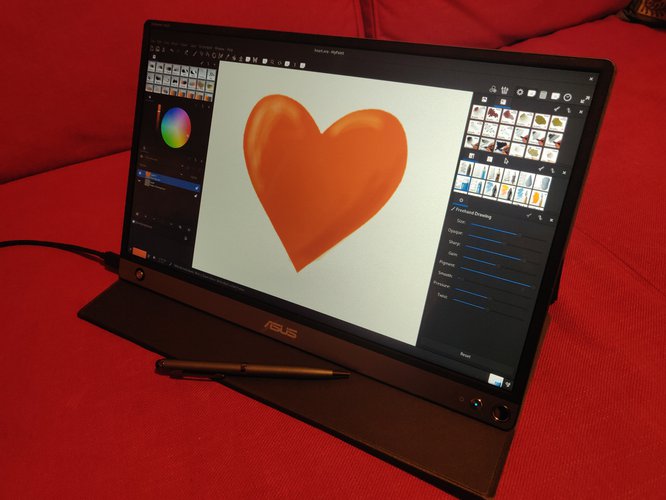
The ASUS ZenScreen Touch, displaying a heart drawn in MyPaint using the stylus and touchscreen.
I bought an ASUS ZenScreen Touch MB16AMT without really know whether it would work properly with my Fedora 33-based Linux laptop, and am delighted to say everything seems to be working.
The ZenScreen Touch has USB-C and Mini HMDI ports, so can connect to my USB-C-only laptop directly. There were no drivers or configuration to have to sort out, and both the display and the touch input work out of the box. The laptop — a Dell XPS 13 7390 — also happily supports two external 1080p displays over USB-C with no issues. The ZenScreen will also optionally slowly charge from the laptop, which is awesome as it means there's only the one cable that you need to plug into the ZenScreen.
The multitouch works as expected, and GNOME has built in gesture support for navigating your desktop (e.g. a three-finger pinch to get to the Activities view). The only small issue is that when you swipe up from the bottom to open the on-screen keyboard it appears on your primary display, which may or may not be your touchscreen. The simple workaround is to set your touchscreen as your primary display in your Displays setting.
If you're interested in drawing then I'd recommend MyPaint, which apparently has good graphics tablet support and works mostly well with a touchscreen.
And if you want to do desktop application development for your touchscreen with Python and GTK then getting touch events is really easy. Though the device itself supports 10 independent touch events, you'll only get up to two at the application level, as I assume the desktop environment intercepts any more than that for its gesture support.
The device comes with a passive capacitive stylus, so I haven't yet been able to see whether it works in GNOME with a USI stylus.
